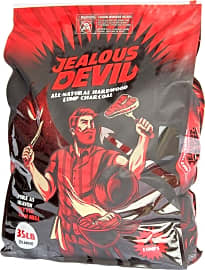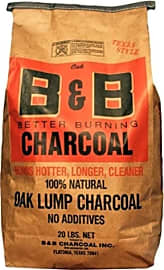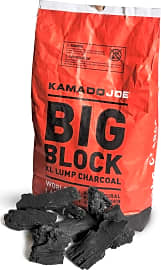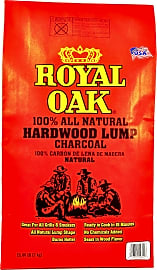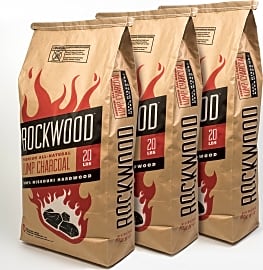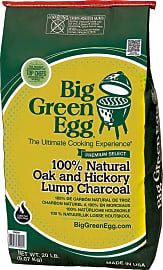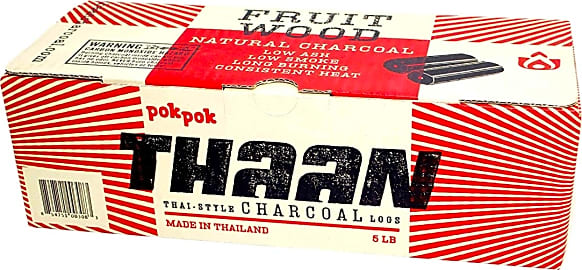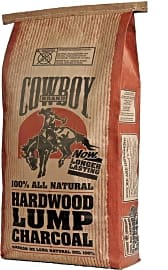The 10 Best Lump Charcoals

This wiki has been updated 40 times since it was first published in October of 2016. Got a hankering for some flavorful meat? Want to really show off at your next barbecue? Then consider switching to one of these lump charcoals. Made from pre-burned wood, it is the purest form of the fuel you'll find anywhere — no chemicals, additives, or lighter fluid added. That means you get nothing but delicious, wood-fired food, which is sure to make you the go-to burger flipper on the block. When users buy our independently chosen editorial picks, we may earn commissions to help fund the Wiki.
Editor's Notes
October 01, 2020:
This list saw a mild shakeup with our latest update, in which we removed Mangrove Hardwood, Fire & Flavor All-Natural, and Grill Dome CCL-20 Choice due to availability concerns. There were plenty of solid contenders to replace them, and so we brought on Cowboy 24220, an affordable, middle of the road option that's ideal for grilling everyday staples when tailgating or camping. Compare that with a higher-end selection like Fogo Super Premium, which is more suitable for top choice cuts or special occasions, and you'll see why either is a smart choice depending on your needs.
We also added B&B Texas Style, another budget-friendly choice that burns hot and lasts. The company takes great pains to ensure there are no foreign materials, chemical binders, or special additives that hasten ignition in its wood and doesn't use small pieces of scrap either.
Harder Charcoal XL is yet another new addition, and like Jealous Devil, it sources extremely dense hardwood from South America. You get a pretty solid bang for your buck when it comes to each 33-pound bag, and it's another ethically sourced, restaurant-style selection with large chunks, making it a good choice for newbies who want something of high quality to experiment with without breaking the bank.
July 01, 2019:
Fogo Super Premium, Kamado Joe, and Jealous Devil remain top names for a reason. They won't give you fits with either lighting or burning time, and they boast a flavor that's neither overpowering nor chemical-laden. They're packaged well, too, especially Jealous Devil, which comes in a resealable waterproof bag that's more robust than the bags used by most other brands. That may seem like a small detail, but you don't want humidity and moisture getting to your lump charcoal in storage.
We also decided to add Pok Pok Thaan, a Thai-style option, which is slightly different than pure lump charcoals, as it's extruded. This makes it better for a ceramic oven than a conventional open grill, because it tends to burn too quickly in the latter. Many people love it, however, because it comes in uniform shapes, thus capturing some of the convenience of briquettes but without the chemicals. It's also less expensive than most binchotan charcoals, so if you've been looking for something a little different than the same-old lump choices, but don't want to spend a mint, this could be one to try.
Special Honors
Hasty Bake Firestarter Gel Getting your coals to burn bright and hot can be tricky for some, which is where this selection from Hasty Bake comes in. They offer an alcohol-based firestarter gel that is odorless, applies easily, starts quickly, and burns cleanly without the lighter fluid taste. You'll also find strike-a-fire matches from Diamond, which burn for 12 minutes apiece. hastybake.com
Grill Masters Club Perfect for those who love to barbecue often, Grill Masters Club is a subscription service that offers curated grilling goods from all over the country. A certified BBQ judge is responsible for selecting award-winning rubs, spice blends, sauces, marinades, wood chips, salts, and accessories for each assortment. Boxes also include a cooking tip, discount code, the history of each item, and a recipe that incorporates them. grillmastersclub.com
A Brief History Of Charcoal
By the 1930s, Ford dealerships were also selling portable grills and bags of charcoal.
Charcoal, a form of half-burnt wood that burns hotter and more slowly than regular logs, has been in use since at least 4000 B.C.E. Originating in Asia, early versions were made by covering wood with moist dirt and lighting the whole thing on fire.
These charred blocks soon became extremely important parts of everyday life. They were used for cooking in huts and homes, as they produced less smoke than other forms of fuel. In addition, blacksmiths used them to melt copper and tin in order to create bronze.
As a result, the creation of charcoal became a full-time job for thousands of people, known as colliers. Their product was so in-demand that entire forests in central Europe were decimated to provide colliers with the raw materials needed to do their jobs, and even today deforestation due to charcoal production is a major environmental concern.
Both the creation and use of charcoal would remain largely unchanged until the 1920s, when an American businessman by the name of Henry Ford found himself with an unusual dilemma. Ford's Model T's were sweeping the nation, and each car required about 100 board feet of hardwood to make. Cutting and shaping all that wood meant that there was plenty of scraps leftover — and to Ford, that meant that he was wasting lots of money.
Ford commissioned a chemist from the University of Oregon to devise a way to turn that lumber into dense lumps of charcoal. He then tapped his cousin — a Michigan real estate agent named Edward Kingsford — to run a factory devoted to turning Ford's scrap into flammable gold.
By the 1930s, Ford dealerships were also selling portable grills and bags of charcoal. Unfortunately, the Great Depression put a damper on sales, and barbecuing took a backseat to survival. After WWII, however, there was plenty of disposable income and leisure time to go around, and the charcoal grill became a hit.
Today, over one million tons of wood scrap get converted to charcoal every year, and it's used in everything from art and medicine to metallurgy and horticulture. Grilling is still its most famous use, however, and charcoal smoke can lend rich flavors to the meat that propane could never hope to match.
The Best Way To Light A Charcoal Grill
Telling someone how to operate their grill is a sensitive subject, and may even be illegal in Texas. However, there are a few common mistakes people make when lighting their fires — some of which can completely defeat the purpose of using charcoal.
You want them to glow red and covered with a thin layer of ash.
The most egregious party foul is going crazy with the lighter fluid. If you absolutely soak your briquettes, that will affect the taste of the meat — and very few people enjoy burgers that taste like gasoline. Some brands come pre-soaked, and if you use those you shouldn't have to add any extra fluid. You should note, however, that you don't even need to use lighter fluid. You can start a great fire with just a few crumpled-up newspapers and a chimney starter.
Don't start grilling until your coals are good and hot, either. You want them to glow red and covered with a thin layer of ash. Once they've gotten to that point, you can take them out of the starter and arrange them inside the grill.
If you expect that it will take a few hours to grill your meat, you should have some additional coals ready, as your original ones will likely burn out after sixty minutes or so. This is another reason to invest in a chimney starter, as you can have your second-string briquettes smoldering while you wait.
In fact, once your guests see you adding more coals to the fire, they may just elect you Grillmaster-for-Life (it's the highest elected office in Texas).
More Charcoal Grilling Tips
Getting your fire started is only the first step to a successful barbecue, of course. Once you add some meat to the equation, the risk of screwing something up increases exponentially. Luckily, I'm here to prevent that from happening.
It may not seem like much, but the manner in which you arrange your coals can make-or-break your cookout. Some meats, like hamburgers, can stand higher heat, and so you'll want to build a charcoal pyramid that brings the fire close to the grill.
Or, if you use natural lump charcoal, you can feed it to your plants, as it makes an excellent fertilizer.
Other foods, like brisket, benefit from a low-and-slow approach. This means cooking them over indirect heat, which requires you to arrange your coals so that the meat isn't being constantly assaulted by the fire. Figure out how much heat your food can handle before you begin, and set up your coals accordingly.
Learn how to use the vents on your grill, as well. These are usually located on the cover and/or the bottom of the grill, and regulate how much airflow the coals receive. If you keep them completely open, your coals will burn extremely hot — but they also won't last long. Conversely, if you close them, you'll trap a lot of smoke inside (until the fire dies from a lack of oxygen, that is).
Likewise, don't lift the lid any more than is absolutely necessary. Yes, the fear of burning the food is powerful, but lifting the lid actually increases the likelihood of that happening, as you're just feeding the fire. Only take the cover off to flip the food, and to occasionally check how done the meat is (using a thermometer, of course).
Once you're done cooking, pour some water on the coals and stir them gently. Let them sit for a day or so, then place them in a non-flammable container and throw them in the trash. Or, if you use natural lump charcoal, you can feed it to your plants, as it makes an excellent fertilizer.



